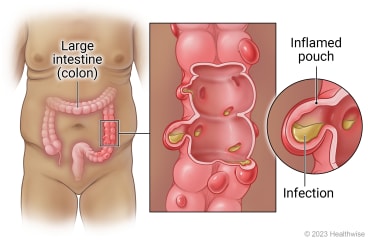What are diverticulosis and diverticulitis?

In diverticulosis and diverticulitis, pouches called diverticula form in the wall of the large intestine, or colon.
- In diverticulosis, the pouches do not cause any pain or other symptoms.
- In diverticulitis, the pouches get inflamed or infected and cause symptoms.
Doctors aren't sure what causes these pouches in the colon. But they think that a low-fiber diet may play a role. A low-fiber diet can cause small, hard stools. This means it takes more pressure in the colon to move stools out of the body. This puts more pressure on the walls of the colon. The pressure from this may cause pouches to form in weak spots along the colon.
What are the symptoms?
- In diverticulosis, most people don't have symptoms.
- In diverticulitis, symptoms may last from a few hours to a week or more. They include:
- Belly pain. This is usually in the lower left side. It is sometimes worse when you move. This is the most common symptom.
- Fever and chills.
- Bloating and gas.
- Diarrhea or constipation.
- Nausea and sometimes vomiting.
- Not feeling like eating.
- If the pouches bleed, it is called diverticular bleeding.
How can you prevent diverticulitis?
You may be able to lower your chance of getting diverticulitis. You can do this by taking steps to prevent constipation.
- Eat fruits, vegetables, beans, and whole grains every day. These foods are high in fiber.
- Drink plenty of fluids. If you have kidney, heart, or liver disease and have to limit fluids, talk with your doctor before you increase the amount of fluids you drink.
- Get at least 30 minutes of exercise on most days of the week. Walking is a good choice.
- Take a fiber supplement (such as Citrucel or Metamucil) every day if needed. Read and follow all instructions on the label.
- Schedule time each day for a bowel movement. Having a daily routine may help. Take your time and do not strain when having a bowel movement.
How are these problems treated?
The best way to treat diverticulosis is to avoid constipation. Treatment for diverticulitis includes antibiotics. It often includes a change in your diet. You may need only liquids at first. Your doctor may suggest medicines for pain or belly cramps. In some cases, surgery may be needed.
Follow-up care is a key part of your treatment and safety. Be sure to make and go to all appointments, and call your doctor if you are having problems. It's also a good idea to know your test results and keep a list of the medicines you take.
Where can you learn more?
Go to http://www.healthwise.net/patientEd
Enter E426 in the search box to learn more about "Learning About Diverticulosis and Diverticulitis".
Current as of: October 19, 2024
Author: Ignite Healthwise, LLC Staff
Clinical Review Board
All Ignite Healthwise, LLC education is reviewed by a team that includes physicians, nurses, advanced practitioners, registered dieticians, and other healthcare professionals.

